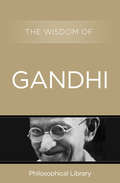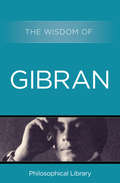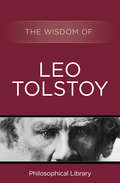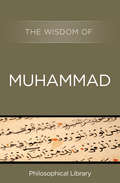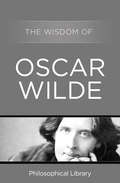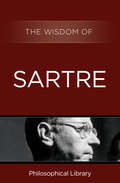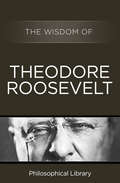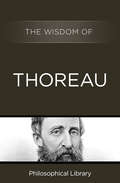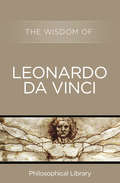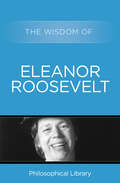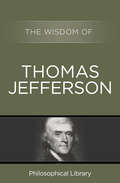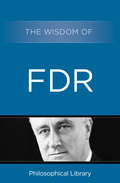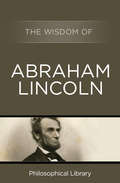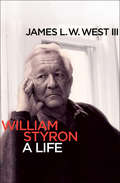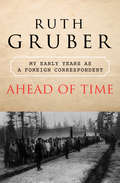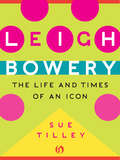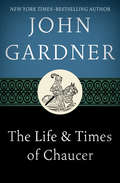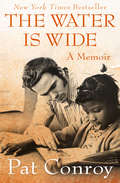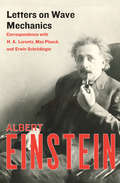- Table View
- List View
The Wisdom of Gandhi (Wisdom)
by Trudy S. SettelBe the Change. Drawn from Gandhi&’s own words, this collection shares one man&’s philosophy that changed world history. When the Indian people, inspired by the words of Mahatma Gandhi, overthrew British rule, they proved that great political change could exist without violence. Revered both as a saint and a master politician in his native country, Gandhi proffered a philosophy that combined Thoreau&’s doctrine of civil disobedience with many Hindu beliefs. A comprehensive introduction to this influential modern thinker, The Wisdom of Gandhi recounts his deeply held views on a variety of topics, including passive resistance, self-discipline, democracy, and even well-being. This is essential text for the history and political reader, as well as anyone looking for words to inspire change.
The Wisdom of Gibran (Wisdom)
by The Wisdom SeriesAn A-to-Z guide to the mystic poet&’s maxims and aphorisms An early twentieth-century Lebanese-American writer, Khalil Gibran instilled his poetry and art with his experiences in both the East and West. This selection of quotes, maxims, and aphorisms is drawn from such poems as &“Secrets of the Heart,&” &“Spirits Rebellious,&” and &“Broken Wings,&” as well as from his autobiography and essays. Gibran&’s words express a strong spirituality and mysticism and his voice offers a direct and at times optimistic view of the brotherhood of man. Addressing everything from love and death to Jesus, motherhood, and nature, Gibran&’s wisdom remains thought provoking and inspirational.
The Wisdom of Gibran (Wisdom)
by The Wisdom SeriesAn A-to-Z guide to the mystic poet&’s maxims and aphorisms An early twentieth-century Lebanese-American writer, Khalil Gibran instilled his poetry and art with his experiences in both the East and West. This selection of quotes, maxims, and aphorisms is drawn from such poems as &“Secrets of the Heart,&” &“Spirits Rebellious,&” and &“Broken Wings,&” as well as from his autobiography and essays. Gibran&’s words express a strong spirituality and mysticism and his voice offers a direct and at times optimistic view of the brotherhood of man. Addressing everything from love and death to Jesus, motherhood, and nature, Gibran&’s wisdom remains thought provoking and inspirational.
The Wisdom of Leo Tolstoy (Wisdom)
by The Wisdom SeriesFollow the renowned novelist&’s journey to his own peace Leo Tolstoy was born to an aristocratic Russian family, became a world-famous influential novelist, and then chose to lead the simple life of a peasant. Dating from this last part of his life, Tolstoy&’s influential book, What I Believe, takes readers along on the path to a life modeled literally on Jesus Christ&’s &“Sermon on the Mount&” and the teachings of the Gospels. In revealing and frank essays he reimagines a faith without dogma, centered solely on Jesus&’s doctrine of love, humility, and self-denial. This collection of chapters from What I Believe includes examinations of Resist Not Evil, Judge Not Thy Neighbor, Letting Go of Fear, and Allowing Forgiveness.
The Wisdom of Leo Tolstoy (Wisdom)
by The Wisdom SeriesFollow the renowned novelist&’s journey to his own peace Leo Tolstoy was born to an aristocratic Russian family, became a world-famous influential novelist, and then chose to lead the simple life of a peasant. Dating from this last part of his life, Tolstoy&’s influential book, What I Believe, takes readers along on the path to a life modeled literally on Jesus Christ&’s &“Sermon on the Mount&” and the teachings of the Gospels. In revealing and frank essays he reimagines a faith without dogma, centered solely on Jesus&’s doctrine of love, humility, and self-denial. This collection of chapters from What I Believe includes examinations of Resist Not Evil, Judge Not Thy Neighbor, Letting Go of Fear, and Allowing Forgiveness.
The Wisdom of Muhammad: The Wisdom Of The Torah, The Wisdom Of The Talmud, The Wisdom Of The Koran, The Wisdom Of Muhammad, And The Wisdom Of Buddha (Wisdom)
by The Wisdom SeriesUncover the tenets of Islam through the words of its founder. This compelling examination of the life and sayings of Muhammad offers the modern reader both a historical context for and a spiritual guide to the principles at the heart of the world&’s second largest religion. Drawing on the Koran and the Sunnah, this collection of quotes is organized by topic from A to Z and provides a window into the eloquence, practicality, and ethical fortitude with which Muhammad preached to his followers. Covering a diverse range of topics, from marriage and civic charity to the individual&’s relationship to God and the afterlife, the Prophet&’s words dispel misconceptions about the history of the faith, its leader, and its core beliefs. With footnotes, a glossary of terms, scriptural citations, and a timeline, The Wisdom of Muhammad is essential reading for anyone who wants to have a true understanding of Islam. &“The ink of the scholar is more holy than the blood of the martyr.&” —Muhammad This ebook edition features a new introduction and image gallery.
The Wisdom of Oscar Wilde (Wisdom)
by the Wisdom ofA comprehensive selection of his quips, aphorisms, and witOne of the most well known personalities of his day, Oscar Wilde charmed and beguiled readers and audiences with his eloquent and biting observations, his smart quips, and the witticisms peppering his own speech and the speech of his characters. The Wisdom of Oscar Wilde collects both his best-loved quotes and longer excerpts, revealing a man wise to human nature and his times, and never shy with his searing comments on men, women, art, behavior, children, politics, youth, and a range of other topics. Drawing from his plays, articles, reviews, speeches, letters, and other works, this definitive volume is an entertaining immersion into the world of this charming genius.
The Wisdom of Sartre (Wisdom)
by The Wisdom SeriesAn invaluable introduction to the leading French intellectual of the twentieth century The Wisdom of Sartre offers key excerpts from the eloquent French writer, playwright, and philosopher&’s masterpiece, Being and Nothingness. From this collection, readers will discover the strongest themes in his early philosophical work: an ontological account of what it means to be human, and the role of perception, knowledge, and consciousness in the practical demands of life. Sartre&’s view that man&’s freedom is a unique source of both misery and pleasure and that the question of which will prevail depends on man&’s awareness and commitment to his freedom is both thought provoking and timely.
The Wisdom of Sigmund Freud (Wisdom)
by The Wisdom SeriesAn invaluable guide to Freud&’s terminology and work. Repression, ego, analysis, neurosis—the language of psychology permeates our modern vocabulary. The brilliant observations of Sigmund Freud form not only the basis for psychoanalysis but also much of our current understanding of the human condition. This essential and approachable guide offers an A-to-Z glossary of terminology defined in Freud&’s own words, including his diagnostic and treatment recommendations as well as his well-known works, including dream interpretation, the Oedipal complex, and the practice of psychoanalysis. This ebook features a new introduction, image gallery, and index of the Hebrew alphabet.
The Wisdom of Theodore Roosevelt
by Philosophical LibraryA fascinating portrait of a dynamic figure in American history Few American presidents stand as such vivid personalities in our history as Theodore Roosevelt. Through this selection of quotations and excerpts, drawn from his speeches, articles, letters, and other writing, this vibrant thinker, politician, outdoorsman, and more relays his passionate feelings on a wide array of subjects. Provided by topic and in chronological order, Roosevelt's quotations show his evolving beliefs on everything from the strenuous life to the bully pulpit, childhood to imperialism, religion to his daughter, Alice. Throughout, the modern reader comes to understand how Roosevelt saw deeply into American society and its problems, and willed the people to mobilize and deal with issues head on.
The Wisdom of Thoreau (Wisdom)
by The Wisdom SeriesA collection of wise words on solitude, simplicity, nature, and life at Walden from the leader of the transcendentalist movement. In excerpts collected here from his most important works, Henry David Thoreau documents his experiences in nature and the wisdom he finds in his explorations of sound, reading, solitude, and other aspects of leading a simple life at Walden. A fearless individualist, Thoreau explored not only poetic naturalism but also a number of ideas that were groundbreaking for his day, including civil disobedience and environmentalism. This introduction to one of America&’s great thinkers shows that as an essayist and poet-philosopher Thoreau remains a relevant voice in the never-ending quest of man to understand his place in the natural terrain.
The Wisdom of Leonardo da Vinci (Wisdom)
by The Wisdom SeriesAn intriguing look inside the mind of the Renaissance genius Leonardo da Vinci stood on a bridge between medieval thought and the modern mind. In this selection of entries from his dozens of coded notebooks and unpublished manuscripts, his unending curiosity in the universe and deep knowledge come through in his energetic style. The self-educated da Vinci developed a philosophical system that set him apart from his contemporaries and marked him as the oracle of a new age, and his vivid imagination and straightforward writing style capture the reader&’s attention whether he is writing about his scientific analysis, his opinion of necromancy, discoveries in nature, or the nature of man. Accompanied by a thorough introduction, The Wisdom of Leonardo da Vinci unveils the man&’s deepest thoughts and musings and proves why he remains an intriguing and enduring figure.
The Wisdom of Eleanor Roosevelt
by Philosophical LibraryNearly five hundred sage observations from the "First Lady of the World"A role model for generations of women, Eleanor Roosevelt lent her passion, support, and life experience to humanitarian causes in the United States and abroad, making her a popular and influential figure of the twentieth century. Both as a first lady and as a public figure, Mrs. Roosevelt championed the poor, minorities, and women. Her work as a civil rights advocate resulted in the desegregation of the armed forces and the creation of the Universal Declaration of Human Rights. Culling quotes from her books, letters, and articles, and also providing timelines, contextual explanations, and a reader's guide, The Wisdom of Eleanor Roosevelt offers a thorough and lasting tribute to a tireless and compassionate leader.
The Wisdom of Jane Austen
by Philosophical LibraryThe perfect companion for Austen's devoted following For over 150 years, Jane Austen has charmed readers with her keen observations and satirical wit. Although set in the parlors and ballrooms of nineteenth-century Britain, her novels continue to resonate deeply with readers as her endearingly imperfect characters share their hopes and foibles, passions and disappointments, in their quest for love and ultimately happy marriage. Collected from her novels, early stories, and letters, The Wisdom of Jane Austen shares her witty and timeless views on a range of subjects, from love and marriage, to fashion and duels, and, of course, pride, prejudice, sense, and sensibility.
The Wisdom of Thomas Jefferson
by Philosophical LibraryA fascinating look inside the mind of an American Renaissance man Statesman. Diplomat. Politician. Scholar. Inventor. Architect. President. Few men exemplify the Enlightenment ideal more than Thomas Jefferson. In this comprehensive collection of quotations from Thomas Jefferson's letters, official communications, and other writings, the dynamic personality and insatiable curiosity of this brilliant man jump off the page and draw us into the young country he so greatly influenced. Whether writing about the right to freedom or the future of Native Americans, the westward expansion or the political climate in France, his personal impressions of historical luminaries or his architectural preferences, his financial troubles or his feelings about religious freedom, Jefferson's convictions are brilliantly explained and often ahead of their time. With seventeen chapters arranged chronologically to highlight the evolution of his thought, as well as a timeline and a cross-section of his finest works, The Wisdom of Thomas Jefferson paints a detailed and revealing portrait of this great man.
The Wisdom of William Shakespeare
by Philosophical LibraryHundreds of ideas and quotations from the pillar of Western literature The playwright Ben Jonson said William Shakespeare was not "of an age but for all time." The most influential and oft-quoted figure in English literature, Shakespeare reveals an uncanny understanding of human behavior, and he imparts his wisdom through the varied voices of his characters. His thoughts on love, friendship, power, politics, injustice, education, humanity, life, death, and grief, here organized by subject, collectively demonstrate that no writer before or since has captured so well the motivations that drive our behavior. In this invaluable collection, scholars and enthusiasts alike will find an easy-to-use and comprehensive guide to the Bard of Avon.
The Wisdom of FDR (Wisdom)
by The Wisdom SeriesHow a great American president communicated a changing worldview What made Franklin Delano Roosevelt an effective leader? His policies and decisions changed our nation&’s and the world&’s history. But more than his skill as a savvy politician and progressive thinker, FDR&’s ability to directly and eloquently voice his thoughts on national concerns, social change, and humanity spoke to and reached the hearts of his people. In this selection of quotes drawn from his speeches and papers, FDR&’s observations and opinions cover everything from faith, war, and peace, to religion, freedom, and the very definition of what it is to be an American. Essays include &“The Four Freedoms,&” &“We Belong to Many Races,&” &“True Education,&” &“The Rights of the Common Man,&” &“Dynamic Democracy,&” and &“Government with a Soul.&”
The Wisdom of Abraham Lincoln
by Philosophical LibraryOne of America's most important presidents and great communicators Remembered for his leadership during the dark years of the Civil War, Abraham Lincoln remains one of the most studied and intriguing figures in American history. Collected from his letters, documents, and speeches, The Wisdom of Abraham Lincoln examines the sixteenth president's statements on politics, the Civil War, slavery, education, law, Reconstruction, and his private life, and offers readers both his most notable remarks in their original context and insight on a variety of earlier and less explored historical events. His wry and self-deprecating humor comes through whether he is speaking of his own election or writing to his wife. Arranged chronologically, Lincoln's quotes reflect his evolution from humble small-town politician to a leader facing his nation's greatest internal crisis and massive social change.
William Styron: A Life
by James L. West IIIA &“mesmerizing&” biography of the #1 New York Times–bestselling author of Sophie&’s Choice, The Confessions of Nat Turner, and Darkness Visible (Entertainment Weekly). William Styron was one of the most highly regarded and controversial authors of his generation. In this illuminating biography, James L. W. West III draws upon letters, papers, and manuscripts as well as interviews with Styron&’s friends and family to recount in rich detail the experiences that shaped each of his groundbreaking books. From Styron&’s Southern upbringing, which deeply influenced the Pulitzer Prize–winning The Confessions of Nat Turner and National Book Award–winning Sophie&’s Choice, to his feud with Norman Mailer and the clinical depression that led to his acclaimed memoir Darkness Visible, West&’s remarkable biography provides invaluable insight into the life and works of a giant of American literature.
Ahead of Time: My Early Years as a Foreign Correspondent
by Ruth GruberThe renowned journalist and Jewish activist looks back on her first 25 years in &“one of the most evocative journalistic autobiographies to appear&” (Publishers Weekly). In this fascinating memoir, Ruth Gruber recalls her first twenty-five years, from her youth in Brooklyn to her astonishing academic accomplishments and groundbreaking journalistic career. She shares her experiences entering New York University at fifteen and just five years later becoming the world&’s youngest person to earn a PhD. She recounts her time in Cologne, Germany, studying during Hitler&’s rise to power, and her adventures in Europe and the Arctic as a reporter for the New York Herald Tribune. Spirited and compelling, Ahead of Time is a striking account of the early years of a woman at the center of the twentieth century&’s turning points.
Leigh Bowery
by Sue TilleyThe definitive biography of one of modern art's most provocative vanguards Leigh Bowery was one of the most controversial and avant-garde performers of his generation. In this fascinating biography, author Sue Tilley, one of Bowery's closest friends, lays bare the extravagant life of the trendsetting entertainer. From Bowery's groundbreaking costumes and performance art, to his notoriety in London's 1980s nightclub culture, to his role as a favored model for painter Lucian Freud, Tilley's engrossing portrait offers insight into the outrageous world of 1980s modern art and the man who came to embody it. This ebook features a new postscript by Sue Tilley and an illustrated biography including rare photos from the author's personal collection.
The Life & Times of Chaucer
by John GardnerThe pinnacle of Gardner&’s medieval scholarship: a fascinating re-creation of the world of one of history&’s greatest writers In this exquisite biography, John Gardner brings to life Geoffrey Chaucer, illuminating his writings and their inspiration like never before. Through exhaustive research and expert storytelling, Gardner takes readers through Chaucer&’s varied career—from writing The Canterbury Tales to performing diplomatic work at the Parliament—and creates a fully realized portrait of an author whose work would remake the English language forever. Written with passion and insight, this a must-read for those interested in Chaucer and the medieval time period. This ebook features a new illustrated biography of John Gardner, including original letters, rare photos, and never-before-seen documents from the Gardner family and the University of Rochester Archives.
The Water Is Wide: A Memoir
by Pat ConroyThe bestselling Pat Conroy memoir--now available as an ebookThe moving story of a young teacher's experience on an island forgotten by the worldThough the children of Yamacraw Island live less than two miles from the coast of South Carolina, they can't name the president or the ocean that surrounds them. Many can't sign their names. Most can't read or write--they're unable to reach their potential to grow and learn because they have been failed by their school district and handicapped by their poverty and isolation. But with the arrival of an eager young teacher, their prospects begin to brighten.Based on Pat Conroy's experiences teaching elementary school for a year on South Carolina's Daufuskie Island, The Water Is Wide is a revealing portrait of the inequalities of the American education system and a powerful story of the group of children that changed one man's life forever.
Letters on Wave Mechanics: Correspondence with H. A. Lorentz, Max Planck, and Erwin Schrödinger (Paperback Ser.)
by Albert EinsteinA lively collection of Einstein&’s groundbreaking scientific correspondence on modern physics Imagine getting four of the greatest minds of modern physics in a room together to explain and debate the theories and innovations of their day. This is the fascinating experience of reading Letters on Wave Mechanics, the correspondence between H. A. Lorentz, Max Planck, Erwin Schrödinger, and Albert Einstein. These remarkable letters illuminate not only the basis of Schrödinger&’s work in wave mechanics, but also how great scientific minds debated and challenged the ever-changing theories of the day and ultimately embraced an elegant solution to the riddles of quantum theory. Their collected correspondence offers insight into both the personalities and professional aspirations that played a part in this theoretical breakthrough. This authorized ebook features rare photos and never-before-seen documents from the Albert Einstein Archives at the Hebrew University of Jerusalem.
Letters on Wave Mechanics: Correspondence with H. A. Lorentz, Max Planck, and Erwin Schrödinger
by Albert EinsteinA lively collection of Einstein&’s groundbreaking scientific correspondence on modern physics Imagine getting four of the greatest minds of modern physics in a room together to explain and debate the theories and innovations of their day. This is the fascinating experience of reading Letters on Wave Mechanics, the correspondence between H. A. Lorentz, Max Planck, Erwin Schrödinger, and Albert Einstein. These remarkable letters illuminate not only the basis of Schrödinger&’s work in wave mechanics, but also how great scientific minds debated and challenged the ever-changing theories of the day and ultimately embraced an elegant solution to the riddles of quantum theory. Their collected correspondence offers insight into both the personalities and professional aspirations that played a part in this theoretical breakthrough. This authorized ebook features rare photos and never-before-seen documents from the Albert Einstein Archives at the Hebrew University of Jerusalem.
